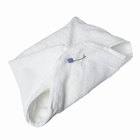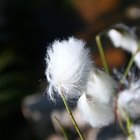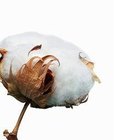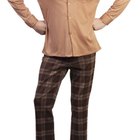
JaysonPhotography/iStock/Getty Images
All wools are known for their warmth, which makes them perfect to use for knit sweaters. Wool wicks away moisture and is a heat insulator; it's also water-resistant and extremely breathable. As a natural fiber, wool blends with other materials, both natural and man-made. While all wools are warm, the different types have other special attributes that make them unique.
Camel-Hair Wool Sweaters
Camel hair used for clothing comes from the hair of a Bactrain camel. It's very expensive to harvest, so many manufacturers weave another wool, such as sheep's wool, into the camel hair to create sweaters. Camel hair is naturally heavy, so heat retention is one of its valuable attributes. The natural color of camel hair, a light tan, is the most common for sweaters made of camel hair. Camel hair is popular in colder climates and is also used for overcoats, hats and quilts.
Cashmere Wool
Cashmere wool is a much more lightweight wool, made from hair of the Kashmir goat. These goats roam the mountains of India, Tibet, Iran, Turkistan, Iraq and China. The goats are not shaved; instead, their outer hair is clipped off and used to weave sweaters and other wool items. Another unique quality of this wool is its extreme loftiness. The goats' hair is kinked, so when it's woven into material, the wool remains plush and soft. The hand, or feel, of this material is luxurious and silky. This wool is one of the most expensive available.
Angora Wool
Angora rabbits provide the wool for angora sweaters. Angora fibers are extremely lofty, yet fragile, making it one of the best wools for retaining heat and repelling moisture. Angora can be expensive, so many manufactures weave the angora fibers with sheep's wool. Because there are few angora rabbit farmers, angora is one of the more expensive wools. Dry cleaning is recommended, but some sweaters can be washed by hand in cool water and gentle soap, and laid flat to dry.
Alpaca Wool
Alpaca comes from the Huacaya and Suri alpaca species. Alpacas have long, heavy hair meant to shield them from the subzero temperatures of the mountaintops where they reside. Alpaca wool is known to repel moisture well while having a very soft hand that's perfect for sweaters. Alpaca characteristics also include its lightweight feel and strength, and it's not likely to pill when worn. Alpaca is generally an affordable, midpriced wool compared with camel hair and cashmere.
Sheep's Wool
Sheep's wool is the one most commonly used for sweaters. On each continent, there are many different kinds of sheep. Loden wool is a greasy wool that sheds water, which makes it the perfect material for the sports coats of outdoor enthusiasts. Merino wool has a very soft hand and comes from the merino sheep of Australia and New Zealand. Shetland sheep hail from the Shetland Islands in the U.K., and their wool is used for high-end cable-knit sweaters. Lambswool is the most expensive sheep's wool; it is also one of the softest.
Related Articles

What Is Superfine Wool?

Fabrics That Haute Couture Designers Use

Microfiber vs. Cotton Clothes

Microfleece Vs. Microplush

What Is Berber Fleece?

What Types of Fabrics Absorb Dye Best?

Define Cotton Silk Fabric

How Does Cotton Help Insulate?

Differences Between Polyester and Nylon ...

What Is Synthetic Hair Made Of?

Wool Vs. Polyester Suits

What Are Clothing Textures?

How to Preserve Moleskin

The Best Kinds of Synthetic, ...

Properties of Cashmere Yarn

What Are Persian Lamb Coats?

The Different Fabrics of Raincoats and ...

Properties of Cotton Fabric

How to Wash Kanekalon

Characteristics of Polyester & Cotton
References
Writer Bio
A journalism graduate from Temple University, Saylor Connors has been a contributing food and travel editor to a digital media company for the past five years. Today, with her husband, a commercial pilot, Connors travels the world and teaches international cooking classes in her spare time.
Photo Credits
JaysonPhotography/iStock/Getty Images